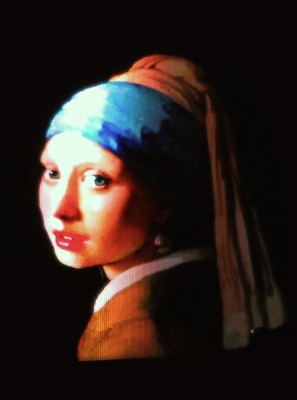May 28 2015
Nanotech Security Corp., announced that the Company has been granted two patents; one from the United States Patent and Trademark Office and one from the European Patent Office. The Company continues to expand the protection of its technology with the addition of these patents to its intellectual property portfolio
 The Girl with the Pearl Earring recreated using Nanotech’s new technology
The Girl with the Pearl Earring recreated using Nanotech’s new technology
Based on these patents the Company has launched “Pearl”, our first foray in plasmonic full colour images. A nano array image of Vermeer’s famous painting “Girl with a Pearl Earring”, which brilliantly displays her ruby lips, blue scarf and bright white collar and features two distinct authentication viewing modes in one feature. The user can view the full colour image in both transmission and reflection (shining a light on or through the image) – an effect impossible for a hologram to achieve. An example of Pearl can be viewed below.
Doug Blakeway, Nanotech Chief Executive Officer, commented, “An initial showing of Pearl to the banknote industry came back with comments of having never seen such a bright visual effect in a security device.” Immediate interest in Pearl has initiated discussions with issuing authorities.
EPO No. 2,563,602 names Charles MacPherson as the inventor. The patent covers layered optically variable devices (“OVDs”) such as colour shift foils that uniquely employs additional interactivity using piezoelectric layers to activate the authentication mode of a security device used as threads in products such as banknotes, passports and secure packaging. This patented multi-layered thin film technology offers Nanotech a competitive edge in the development of colour shifting security devices.
USPTO No. 9,013,272 names Dr. Bozena Kaminska and Clint Landrock as co-inventors. Building on patents previously granted to Nanotech, this patent secures integral intellectual property, which covers a range of diffractive and plasmonic luminescent devices such as security features used in banknotes.
Clint Landrock, Nanotech Chief Technology officer, commented, “We are pleased to be granted these additional patents as they further solidify our hold on the next generation of authentication technologies for the banknote, branding and secure document industries.”
Nanotech has developed some novel high resolution OVD effects based on nano-hole arrays, which differ from conventional OVDs providing easy recognition and verification. These nano-hole structures create new colour shifting effects that provide unique visual features such as 3D, HD, and motion. These unique features are easily communicated to the public making Nanotech’s overt security features easier to recognize and authenticate.
The Company has also created colour switching effects with predetermined contrast changes. When the device is rotated colours switch, for example from magenta to gold or blue to green, making for a distinct and recognizable security image. With its KolourOptik™ technology Nanotech has also created colours such as white and black, which has not yet been seen in conventional OVDs. The bright colours and unique visual characteristics not only appeal to human perceptions, but also reinforce a device’s security properties as they cannot be reproduced by copying or classical holography.
Nanotech is now focusing its efforts on commercial applications of it’s technology; making overt authentication security elements available for integration into banknotes, passports, identity cards, tax stamps, and other security documents.
Source: http://www.nanosecurity.ca/